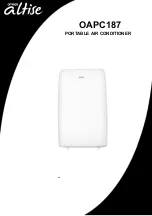
Page 9
S
ECTION
3 - I
NSTALLATION
3.8 Installing an External Liquid Rinse Aid
System
A pre-plumbed, blue 1/4” ID tube at the lower
rear of the unit serves as the connection point
for the rinse aid supply. See Figure 3-10.
If a liquid rinse aid system will NOT be used,
cut the tubing near the rear panel. Then, close
and seal it with the plug and wire clamp that
are supplied on the end of the tube. See
Figure 3-8.
To install a liquid rinse aid dispensing system:
1. Route the rinse aid supply line to the blue
1/4” ID tube at the lower rear of the
machine.
2. Fasten the line in place and seal the
connection.
3. Check that the pump is correctly installed
according to the manufacturer’s
instructions.
3.9 Wiring External Chemical Dispensing
Systems
IMPORTANT
Some local codes dictate that electrical
connections be made only by a certified
professional.
1. Locate the chemical dispenser terminal
block. See Figure 3-3.
2. Thread the incoming leads from the
chemical pumps through the extra strain
reliefs (at the lower rear of machine) and
to the chemical dispenser terminal block.
3. Connect the wires as shown in Figure
3-11. Note that the terminal block supplies
LINE VOLTAGE SIGNALS. An additional
transformer may be required depending
on the supply requirements of the external
pumps.
4. Adjust the strain reliefs to fasten the wiring
in place. Leave enough slack in the wiring
to prevent stress on the terminal
connections. Bundle the wires together
using wire ties to prevent them from
tangling when repositioning the appliance.
Figure 3-10: Liquid rinse additive system
Liquid rinse
additive
injection
(blue)
Figure 3-11: Dispenser pump wiring










































